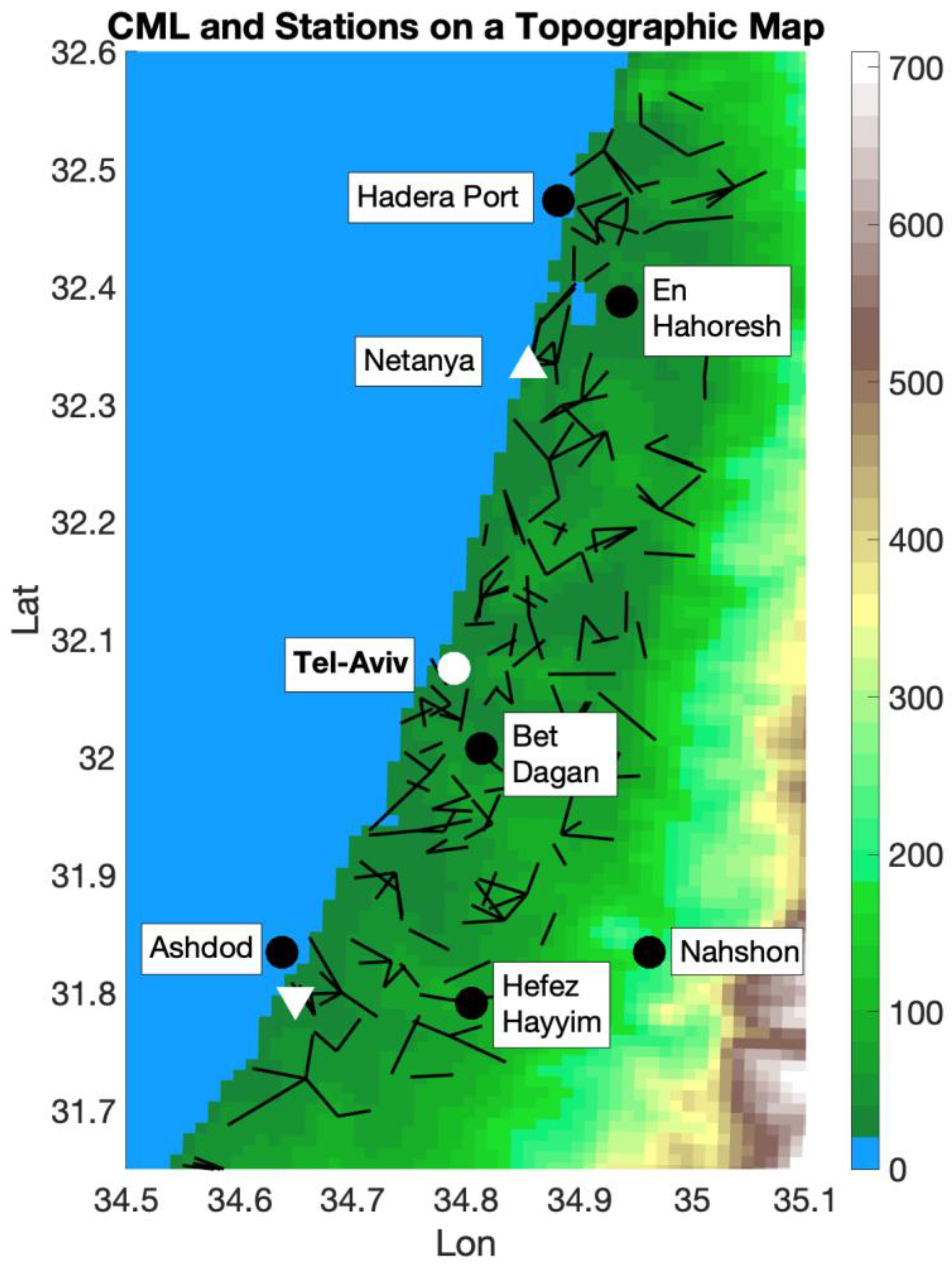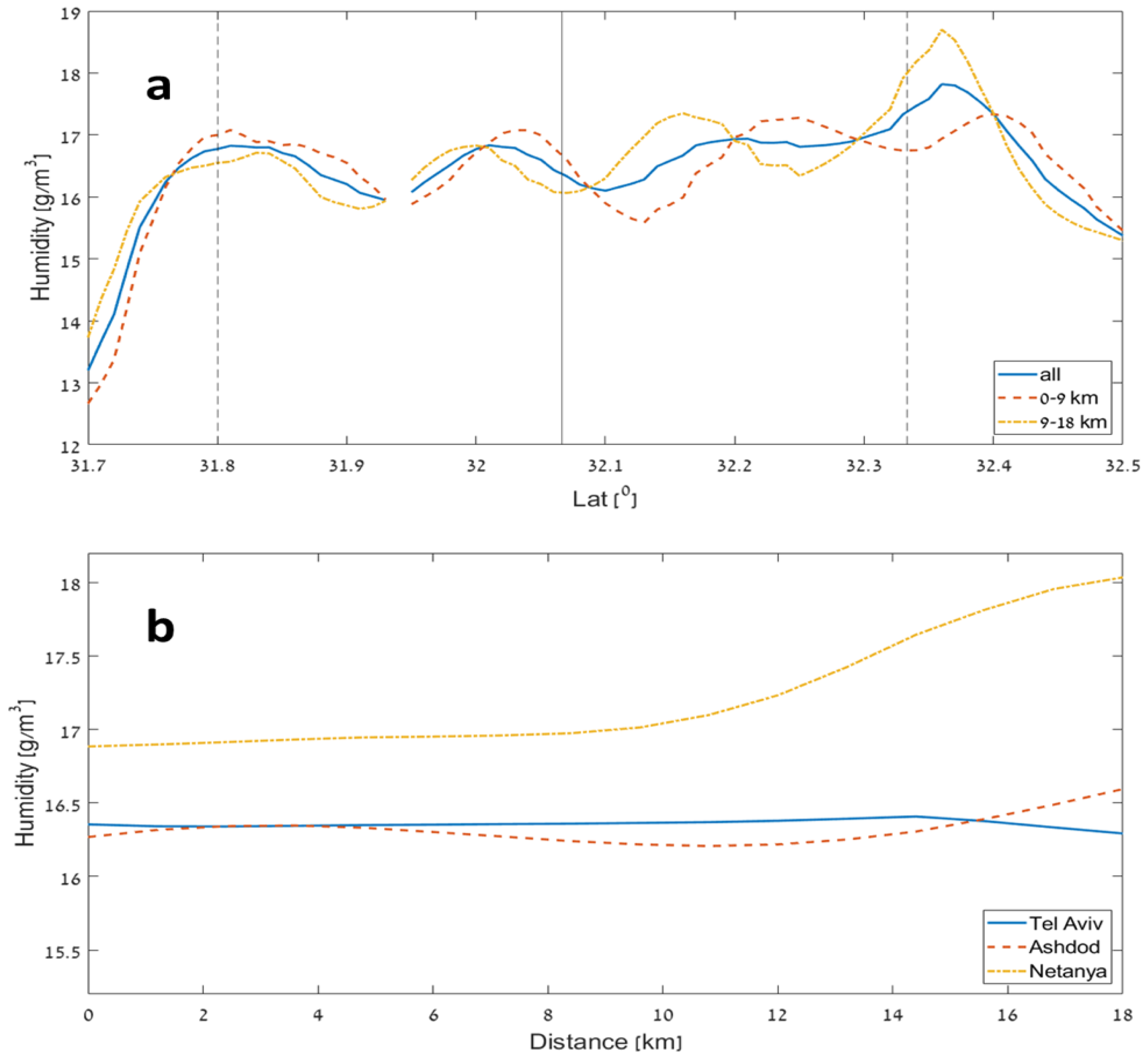High-Resolution Humidity Observations Based on Commercial Microwave Links (CML) Data—Case of Tel Aviv Metropolitan Area
Abstract
1. Introduction
2. Methods
2.1. Research Area and Period
2.2. Links Characteristics
2.3. CML-Based Humidity Retrievals
2.4. Calibration
2.5. Interpolation Method
3. Results and Discussion
3.1. Validation and Performances Assessment
3.2. Humidity Maps: Average for July 2017
3.3. LC and the Humidity Cross-Sections for Different Latitudes
4. Conclusions
- -
- The humidity field is influenced by different LCs, with high humidity observed above agricultural areas that are characterized by vegetation and are often irrigated during the dry summer period.
- -
- Around the urban areas, the absolute humidity values are found to be lower compared to the surrounding area when the city is located in a wetter, temperate Mediterranean climate (e.g., Netanya) and higher when the city is located in a dry, semi-arid climate (e.g., Ashdod).
- -
- The large metropolitan area of Tel Aviv shows a combination of both characteristics due to its location, being just on the semi-arid border.
Supplementary Materials
Author Contributions
Funding
Data Availability Statement
Acknowledgments
Conflicts of Interest
Abbreviations
| AMSL | Above mean sea level |
| CML | Commercial microwave links |
| CML-HO | CML humidity observations |
| ECMWF | European Centre for Medium-Range Weather forecasts |
| IMS | Israeli Meteorological Service |
| LC | Land cover |
| NWP | Numerical weather prediction |
| QE | Quantization error |
| RMSD | Root mean square deviation |
| RSL | Received signal level |
| STD | Standard deviation |
| TSL | Transmit signal level |
| UHI | Urban heat island |
| WS-HO | Weather station humidity observations |
| WV | Water vapor |
References
- United Nations. World Urbanization Prospects: The 2018 Revision; United Nations: New York, NY, USA, 2019. [Google Scholar] [CrossRef]
- Luo, Z.; Liu, J.; Zhang, Y.; Zhou, J.; Yu, Y.; Jia, R. Spatiotemporal characteristics of urban dry/wet islands in China following rapid urbanization. J. Hydrol. 2021, 601, 126618. [Google Scholar] [CrossRef]
- Richards, K. Urban and rural dewfall, surface moisture, and associated canopy-level air temperature and humidity measurements for Vancouver, Canada. Bound.-Layer Meteorol. 2005, 114, 143–163. [Google Scholar] [CrossRef]
- Hage, K.D. Urban-Rural Humidity Differences. J. Appl. Meteorol. 1975, 14, 1277–1283. [Google Scholar] [CrossRef]
- Wang, J.A.; Hutyra, L.; Li, D.; Friedl, M.A. Gradients of atmospheric temperature and humidity controlled by local urban land-use intensity in Boston. J. Appl. Meteorol. Climatol. 2017, 56, 817–831. [Google Scholar] [CrossRef]
- Hill, A.C.; Mitchell, M.; Yuan, F.; Ruhland, C.T. Intensification of Midwestern Agriculture as a Regional Climate Modifier and Atmospheric Boundary Layer Moisture Source. Ann. Am. Assoc. Geogr. 2019, 109, 1775–1794. [Google Scholar] [CrossRef]
- Theeuwes, N.E.; Barlow, J.; Teuling, A.; Grimmond, C.; Kotthaus, S. Persistent cloud cover over mega-cities linked to surface heat release. Npj Clim. Atmos. Sci. 2019, 2, 15. [Google Scholar] [CrossRef]
- Dou, J.; Wang, Y.; Bornstein, R.; Miao, S. Observed spatial characteristics of Beijing urban climate impacts on summer thunderstorms. J. Appl. Meteorol. Climatol. 2015, 54, 94–105. [Google Scholar] [CrossRef]
- Pielke Sr, R.A.; Adegoke, J.; BeltraáN-Przekurat, A.; Hiemstra, C.A.; Lin, J.; Nair, U.S.; Niyogi, D.; Nobis, T.E. An overview of regional land-use and land-cover impacts on rainfall. Tellus B Chem. Phys. Meteorol. 2007, 59, 587–601. [Google Scholar] [CrossRef]
- Shepherd, J.M. A review of current investigations of urban-induced rainfall and recommendations for the future. Earth Interact. 2005, 9, 1–27. [Google Scholar] [CrossRef]
- Ben-Gai, T.; Bitan, A.; Manes, A.; Alpert, P. Long-term change in October rainfall patterns in southern Israel. Theor. Appl. Climatol. 1993, 46, 209–217. [Google Scholar] [CrossRef]
- Dixon, P.G.; Mote, T.L. Patterns and Causes of Atlanta’s Urban Heat Island–Initiated Precipitation. J. Appl. Meteorol. 2003, 42, 1273–1284. [Google Scholar] [CrossRef]
- Sailor, D.J. A review of methods for estimating anthropogenic heat and moisture emissions in the urban environment. Int. J. Climatol. 2011, 31, 189–199. [Google Scholar] [CrossRef]
- Daramola, M.T.; Balogun, I.A. Local climate zone classification of surface energy flux distribution within an urban area of a hot-humid tropical city. Urban Clim. 2019, 29, 100504. [Google Scholar] [CrossRef]
- Chen, C.-T.; Roeckner, E.; Soden, B.J. A Comparison of Satellite Observations and Model Simulations of Column-Integrated Moisture and Upper-Tropospheric Humidity. J. Clim. 1996, 9, 1561–1585. [Google Scholar] [CrossRef]
- Uzan, L.; Egert, S.; Khain, P.; Levi, Y.; Vadislavsky, E.; Alpert, P. Ceilometers as planetary boundary layer height detectors and a corrective tool for COSMO and IFS models. Atmospheric Chem. Phys. 2020, 20, 12177–12192. [Google Scholar] [CrossRef]
- Ziv, S.Z.; Alpert, P.; Reuveni, Y. Long-term variability and trends of precipitable water vapour derived from GPS tropospheric path delays over the Eastern Mediterranean. Int. J. Climatol. 2021, 41, 6433–6454. [Google Scholar] [CrossRef]
- Ziv, S.Z.; Yair, Y.; Alpert, P.; Uzan, L.; Reuveni, Y. The diurnal variability of precipitable water vapor derived from GPS tropospheric path delays over the Eastern Mediterranean. Atmos. Res. 2021, 249, 105307. [Google Scholar] [CrossRef]
- Alpert, P.; Rubin, Y. First Daily Mapping of Surface Moisture from Cellular Network Data and Comparison with Both Observations/ECMWF Product. Geophys. Res. Lett. 2018, 45, 8619–8628. [Google Scholar] [CrossRef]
- Messer, H.; Zinevich, A.; Alpert, P. Environmental monitoring by wireless communication networks. Science 2006, 312, 713. [Google Scholar] [CrossRef]
- Leijnse, H.; Uijlenhoet, R.; Stricker, J.N.M. Rainfall measurement using radio links from cellular communication networks. Water Resour. Res. 2007, 43, 1–6. [Google Scholar] [CrossRef]
- Zinevich, A.; Messer, H.; Alpert, P. Frontal rainfall observation by a commercial microwave communication network. J. Appl. Meteorol. Climatol. 2009, 48, 1317–1334. [Google Scholar] [CrossRef]
- Zinevich, A.; Alpert, P.; Messer, H. Estimation of rainfall fields using commercial microwave communication networks of variable density. Adv. Water Resour. 2008, 31, 1470–1480. [Google Scholar] [CrossRef]
- Alpert, P.; Messer, H.; David, N. Meteorology: Mobile networks aid weather monitoring. Nature 2016, 537, 617. [Google Scholar] [CrossRef]
- David, N.; Sendik, Q.; Messer, H.; Alpert, P. Cellular network infrastructure: The future of fog monitoring? Bull. Am. Meteorol. Soc. 2015, 96, 1687–1698. [Google Scholar] [CrossRef]
- David, N.; Alpert, P.; Messer, H. Technical note: Novel method for water vapour monitoring using wireless communication networks measurements. Atmos. Chem. Phys. 2009, 9, 2413–2418. [Google Scholar] [CrossRef]
- David, N. Analyzing the ability to reconstruct the moisture field using commercial microwave network data. Atmos. Res. 2019, 219, 213–222. [Google Scholar] [CrossRef]
- Oharel; David, N.; Alpert, P.; Messer, H. The Potential of Microwave Communication Networks to Detect Dew—Experimental Study. IEEE J. Sel. Top. Appl. Earth Obs. Remote Sens. 2015, 8, 4396–4404. [Google Scholar] [CrossRef]
- David, N.; Gao, H.O. Using Cellular Communication Networks To Detect Air Pollution. Environ. Sci. Technol. 2016, 50, 9442–9451. [Google Scholar] [CrossRef]
- Chwala, C.; Kunstmann, H. Commercial microwave link networks for rainfall observation: Assessment of the current status and future challenges. WIREs Water 2019, 6. [Google Scholar] [CrossRef]
- Ostrometzky, J.; Eshel, A. Empirical Study of the Quantization Induced Bias in Commercial Microwave Links’ Min/Max Attenuation Measurements for Rain Monitoring. Environments 2018, 5, 80. [Google Scholar] [CrossRef]
- Ostrometzky, J.; Eshel, A.; Alpert, P.; Messer, H. Induced bias in attenuation measurements taken from commercial microwave links. In Proceedings of the 2017 IEEE International Conference on Acoustics, Speech and Signal Processing (ICASSP), New Orleans, LA, USA, 5–9 March 2017; pp. 3744–3748. [Google Scholar] [CrossRef]
- Leijnse, H.; Uijlenhoet, R.; Berne, A. Errors and Uncertainties in Microwave Link Rainfall Estimation Explored Using Drop Size Measurements and High-Resolution Radar Data. J. Hydrometeorol. 2010, 11, 1330–1344. [Google Scholar] [CrossRef]
- Zinevich, A.; Messer, H.; Alpert, P. Prediction of rainfall intensity measurement errors using commercial microwave communication links. Atmos. Meas. Tech. 2010, 3, 1385–1402. [Google Scholar] [CrossRef]
- Eshel, A.; Messer, H.; Kunstmann, H.; Alpert, P.; Chwala, C. Quantitative Analysis of the Performance of Spatial Interpolation Methods for Rainfall Estimation Using Commercial Microwave Links. J. Hydrometeorol. 2021, 22, 831–843. [Google Scholar] [CrossRef]
- Eshel, A.; Ostrometzky, J.; Gat, S.; Alpert, P.; Messer, H. Spatial Reconstruction of Rain Fields From Wireless Telecommunication Networks—Scenario-Dependent Analysis of IDW-Based Algorithms. IEEE Geosci. Remote Sens. Lett. 2020, 17, 770–774. [Google Scholar] [CrossRef]
- Overeem, A.; Leijnse, H.; Uijlenhoet, R. Retrieval algorithm for rainfall mapping from microwave links in a cellular communication network. Atmos. Meas. Tech. 2016, 9, 2425–2444. [Google Scholar] [CrossRef]
- Alpert, P.; Osetinsky, I.; Ziv, B.; Shafir, H. Semi-objective classification for daily synoptic systems: Application to the eastern Mediterranean climate change. Int. J. Climatol. 2004, 24, 1001–1011. [Google Scholar] [CrossRef]
- Goldreich, Y. The Climate of Israel; Springer: Boston, MA, USA, 2003. [Google Scholar] [CrossRef]
- Skibin, D.; Hod, A. Subjective analysis of mesoscale flow patterns in northern Israel. J. Appl. Meteorol. 1979, 18, 329–338. [Google Scholar] [CrossRef]
- Alpert, P.; Getenio, B.; Zak-Rosenthal, R. One-level modeling for diagnosing surface winds over complex terrain. Part II: Applicability to short-range forecasting. Mon. Weather. Rev. 1988, 116, 2047–2061. [Google Scholar] [CrossRef]
- Liebe, H.J. An updated model for millimeter wave propagation in moist air. Radio Sci. 1985, 20, 1069–1089. [Google Scholar] [CrossRef]
- van Vleck, J.H. The Absorption of Microwaves by Uncondensed Water Vapor. Phys. Rev. 1947, 71, 425–433. [Google Scholar] [CrossRef]
- Yoav, R. A Novel Approach for High Resolution Humidity Mapping Based on Cellular Net-work Data. Tel-Aviv. 2018. Available online: https://web2.eng.tau.ac.il/wtest/rainlinklab/wp-content/uploads/2020/07/Thesis-Yoav-Rubin.pdf (accessed on 23 October 2022).
- Rubin, Y.; Rostkier-Edelstein, D.; Chwala, C.; Alpert, P. Challenges in Diurnal Humidity Analysis from Cellular Microwave Links (CML) over Germany. Remote Sens. 2022, 14, 2353. [Google Scholar] [CrossRef]
- Cressman, G.P. An Operational Objective Analysis System. Mon. Weather Rev. 1959, 87, 367–374. [Google Scholar] [CrossRef]
- Oke, T.R. Boundary Layer Climates; Routledge: London, UK; New York, NY, USA, 2002. [Google Scholar]
- Landsberg, H.E. The Urban Climate; Academic Press: New York, NY, USA.
- Elhacham, E.; Alpert, P. Impact of coastline-intensive anthropogenic activities on the atmosphere from moderate resolution imaging spectroradiometer (MODIS) data in Dubai (2001–2014). Earths Future 2016, 4, 54–61. [Google Scholar] [CrossRef]






Disclaimer/Publisher’s Note: The statements, opinions and data contained in all publications are solely those of the individual author(s) and contributor(s) and not of MDPI and/or the editor(s). MDPI and/or the editor(s) disclaim responsibility for any injury to people or property resulting from any ideas, methods, instructions or products referred to in the content. |
© 2023 by the authors. Licensee MDPI, Basel, Switzerland. This article is an open access article distributed under the terms and conditions of the Creative Commons Attribution (CC BY) license (https://creativecommons.org/licenses/by/4.0/).
Share and Cite
Rubin, Y.; Sohn, S.; Alpert, P. High-Resolution Humidity Observations Based on Commercial Microwave Links (CML) Data—Case of Tel Aviv Metropolitan Area. Remote Sens. 2023, 15, 345. https://doi.org/10.3390/rs15020345
Rubin Y, Sohn S, Alpert P. High-Resolution Humidity Observations Based on Commercial Microwave Links (CML) Data—Case of Tel Aviv Metropolitan Area. Remote Sensing. 2023; 15(2):345. https://doi.org/10.3390/rs15020345
Chicago/Turabian StyleRubin, Yoav, Shira Sohn, and Pinhas Alpert. 2023. "High-Resolution Humidity Observations Based on Commercial Microwave Links (CML) Data—Case of Tel Aviv Metropolitan Area" Remote Sensing 15, no. 2: 345. https://doi.org/10.3390/rs15020345
APA StyleRubin, Y., Sohn, S., & Alpert, P. (2023). High-Resolution Humidity Observations Based on Commercial Microwave Links (CML) Data—Case of Tel Aviv Metropolitan Area. Remote Sensing, 15(2), 345. https://doi.org/10.3390/rs15020345









